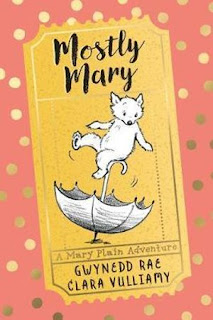Continuing my
occasional series of reflections on books with bears in them, this week I’ll be
looking at a chapter book for children:
I was introduced to
Mary by a bear called Paddington.
I mean that,
literally. I bought a hard cover edition of A
Bear Called Paddington in Paddington station when I visited London (why
wouldn’t you?) and the blurb on the book jacket included a very interesting
sentence:
“Like Winnie the Pooh
and Mary Plain, Paddington is a bear to remember.”
Now, I am quite
familiar with Winnie the Pooh. Even if Disney hadn’t made sure I had that
“tubby little cubby all stuffed with fluff” on my radar from an early age, I
probably would have encountered Christopher Robin and the good folk of the 100
Aker Wood through the story books my mother bought for me as a child.
But Mary Plain? I’d
never heard of her. Here she was, being mentioned in the same breath as Winnie
the Pooh and Paddington (two much beloved bears), but she was a complete
mystery to me.
Well, I did what any
librarian would do. I googled Mary Plain and discovered she was the heroine of
a series of books published from the 30s through to the 60s. She was,
apparently, quite a popular character at one point. So why had I never heard of
her?
Unfortunately, none of
my libraries had a copy of any of the Mary Plain books, but it just so happened
that four of the books had been recently reissued with new illustrations by
Clara Vulliamy. I ordered the first two books, and sat down to meet a new
friend.
There’s something you
have to remember about Mostly Mary.
It was written in 1930 as light entertainment for children. So it is a
cheerful, light-hearted, entertaining book… about a terrible zoo that would
never be built in a civilised society in this day and age.
I visited the bear pits in Bern a few years ago, and the old pits weren’t in use at the time – they now have the
bears in a park along the river bank where they have some space to roam and
grass and trees and things (although I understand these are connected to the
pits with a tunnel, so the bears can use both spaces). When I saw the bear pits, it made me sad
to think that bears would spend their whole lives in those concrete bunkers.
Now, thanks to Mary Plain, I know that people also threw random crap at them
while they were in there.
Gwynned Rae used to
visit the zoo while she was living in Bern in the 1920s, and the bears were
the highlight of the zoo for her. She imagined them as being like a family with
small children, going about their business being bears in a pit, and that’s the
angle from which she has written this book. Mary is very much like a child, but
not completely anthropomorphised. The book consists of a series of stories
(mostly about Mary, but some of the other bears take the lead in a few stories
– hence the title). During these stories, the bears are playful, happy and
interested in the world around them.
But they’re in a
terrible zoo, during a time when people treated animals with little respect, and I kept coming across parts of the book that were
supposed to be “oh, how dear!” moments, but were actually “well, that’s a bit
sad, really” moments instead.
Mary overhears one of
the humans commenting about her, saying “isn’t Mary plain?” and she thinks this
must be her full name – she gets so excited and happy about this that she runs
to her favourite part of the concrete bunker and hugs herself because there was
no one else around to hug. People throw stuff at the bears all the time, and
that’s pretty much the most interesting thing that happens to them, so they
like to play with the random crap that has been tossed at them. People also
throw food at them – often carrots bought from a stall, but also “treats” like
honey and condensed milk, and the bears practically live for these moments.
There is one lone tree in each of the pits, and they’ve been used so much that
the lower branches are all broken off…
There’s a point in the
book where Mary is put on a leash and taken to some rich person’s party. This
is supposed to be an awfully big adventure for the young bear, but all I could
think of is, “Really? This was something they did in the 20s? Rented bear cubs
from the zoo as party tricks?”
And this charming,
happy-go-lucky bear cub is just so
excited to encounter every crappy part of her crappy little life.
I wanted to love this
book, but we’re in a different place now (thank God), and it’s hard to love
something that cheerfully celebrates a mistake we made in our ignorance that we
regret deeply (at least, we should regret it deeply – I’m sure there are some
people who don’t, but those people are the ones who never stopped to ask “but
what must it be like?”).
A child who has never
seen the pits and hasn’t got a full appreciation for how terrible the zoos from
that time were would probably enjoy the book and fall in love with Mary. I wish
them luck. Personally, I have to wait a little longer before I can bring myself
to read the second one.

